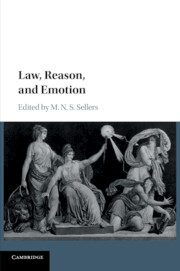Book contents
- Law, Reason, and Emotion
- IVR Studies in the Philosophy of Law and Social Philosophy
- Law, Reason, and Emotion
- Copyright page
- Dedication
- Contents
- Contributors
- Preface
- 1 Introduction
- 2 Law, Reason, and Emotion
- 3 Law’s Emotions
- 4 The Constitutional Domestication of Emotions
- 5 Mind and Rights: Neuroscience, Philosophy, and the Foundations of Legal Justice
- 6 Rights, Reason, and Emotion: Conflict and Balance of Rights
- 7 The Law of Honor
- 8 Interactive Reason in Law
- 9 The Wrath of Reason and The Grace of Sentiment: Vindicating Emotion in Law
- Index
- References
4 - The Constitutional Domestication of Emotions
Published online by Cambridge University Press: 15 December 2017
- Law, Reason, and Emotion
- IVR Studies in the Philosophy of Law and Social Philosophy
- Law, Reason, and Emotion
- Copyright page
- Dedication
- Contents
- Contributors
- Preface
- 1 Introduction
- 2 Law, Reason, and Emotion
- 3 Law’s Emotions
- 4 The Constitutional Domestication of Emotions
- 5 Mind and Rights: Neuroscience, Philosophy, and the Foundations of Legal Justice
- 6 Rights, Reason, and Emotion: Conflict and Balance of Rights
- 7 The Law of Honor
- 8 Interactive Reason in Law
- 9 The Wrath of Reason and The Grace of Sentiment: Vindicating Emotion in Law
- Index
- References
- Type
- Chapter
- Information
- Law, Reason, and Emotion , pp. 55 - 79Publisher: Cambridge University PressPrint publication year: 2017



